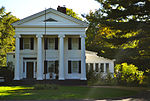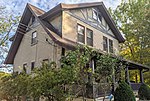Church of St. Martin de Porres (Poughkeepsie, New York)
1852 establishments in New York (state)19th-century Roman Catholic church buildings in the United StatesAustrian-American historyCatholic elementary schools in New York (state)German-American culture in New York (state) ... and 8 more
Postmodern architecture in New York (state)Private elementary schools in New York (state)Private middle schools in New York (state)Religious organizations established in 1852Roman Catholic churches completed in 1859Roman Catholic churches in New York (state)Roman Catholic churches in Poughkeepsie, New YorkSchools in Dutchess County, New York
The Church of St. Martin de Porres is a Roman Catholic parish church under the authority of the Roman Catholic Archdiocese of New York, located in Poughkeepsie, Dutchess County, New York.
Excerpt from the Wikipedia article Church of St. Martin de Porres (Poughkeepsie, New York) (License: CC BY-SA 3.0, Authors).Church of St. Martin de Porres (Poughkeepsie, New York)
Cedar Valley Road, Town of Poughkeepsie
Geographical coordinates (GPS) Address Nearby Places Show on map
Geographical coordinates (GPS)
| Latitude | Longitude |
|---|---|
| N 41.66075 ° | E -73.881694444444 ° |
Address
Cedar Valley Road 116
12603 Town of Poughkeepsie
New York, United States
Open on Google Maps








